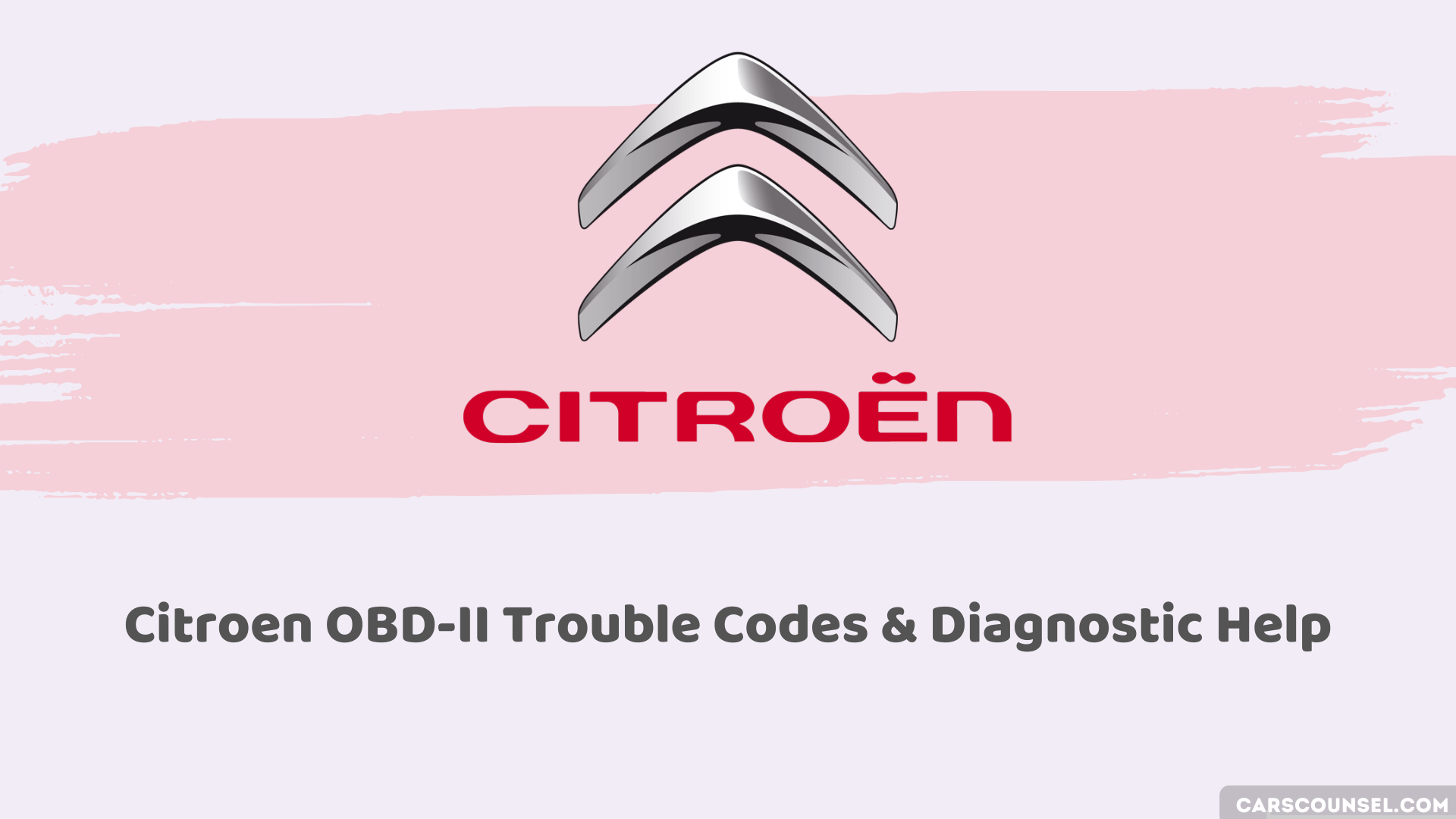When your Citroen’s Check Engine light suddenly illuminates on the dashboard, you’re left wondering what’s going on under the hood. Maybe it’s a faulty oxygen sensor or a loose gas cap – or maybe it’s something more serious. Whatever the issue, the key to uncovering the problem lies in the cryptic five-digit code retrieved by an OBD-II scanner.
But what do these codes really mean, and how do you use them to diagnose and fix the problem? The answers to these questions can make all the difference in getting your Citroen back on the road quickly and efficiently.

Quick Navigation
Understanding Citroen OBD-II Codes
When troubleshooting issues with your Citroen vehicle, deciphering OBD-II codes is essential for accurate diagnosis and repair.
Citroen OBD-II codes are part of the self-diagnostic system, indicating specific component issues with a five-digit code consisting of a letter and four numbers.
The first character of the code indicates the system associated with the fault, such as P for powertrain system issues or C for chassis system issues.
You can use an OBD-II scanner to communicate with your vehicle’s onboard computer and retrieve diagnostic trouble codes (DTCs).
This provides valuable information for diagnosis and repair, helping you identify issues with the fuel system, engine power, or emissions systems that may trigger the Check Engine light.
Reading and Clearing OBD-II Codes
Now that you’ve accessed the OBD-II codes, it’s time to learn how to read and clear them.
When reading OBD-II codes, you’ll notice they consist of five letters and digits, each conveying a distinct meaning. An OBD-II scanner can identify issues within your vehicle’s systems by retrieving diagnostic trouble codes (DTCs), which provide valuable information about the troubled vehicle system or circuit.
- Clearing codes can improve fuel efficiency, resulting in cost savings, reduced emissions, and positive environmental impacts.
- Some codes may clear on their own after a series of successful drive cycles, but it’s generally not advisable to clear codes without addressing underlying issues.
- OBD-II scanners are particularly useful for monitoring and clearing codes related to the fuel system and emissions, allowing for prompt diagnosis and repair of issues.
Preventing and Handling OBD-II Codes
Regular maintenance is key to preventing OBD-II codes from occurring in the first place.
By staying on top of routine inspections, fluid changes, and timely repairs, you can reduce the likelihood of triggering codes. This proactive approach helps prevent minor issues from escalating into more significant, expensive repairs.
You’ll also improve fuel efficiency, resulting in cost savings, reduced emissions, and positive environmental impacts.
When an OBD-II code does occur, understanding its structure and meaning is vital.
For instance, a code P might indicate an issue with your engine oil or Evaporative Emission Control system, while a generic code could point to a problem with your vehicle’s computer or speed sensor.
Swiftly addressing these codes and associated issues will minimize vehicle downtime and reduce repair expenses.
Most Common Citroen OBD-II Trouble Codes
| Code | Description |
|---|---|
| P1100 | MAF sensor intermittent |
| P1101 | MAF sensor Out of self test range |
| P1102 | MAF sensor lower than expected |
| P1103 | MAF sensor higher than expected |
| P1104 | MAF ground malfunction |
| P1110 | Intake air temperature sensor open/short |
| P1111 | Intake air temperature sensor high voltage |
| P1112 | Intake air temperature sensor low voltage |
| P1113 | Intake air temperature sensor open/short |
| P1114 | Engine coolant temperature sensor low voltage |
| P1115 | Engine coolant temperature sensor high voltage |
| P1116 | Engine coolant temperature sensor out of range |
| P1251 | Air mixture solenoid circuit malfunction |
| P1252 | Pedal correlation PDS1 & LPDS High |
| P1253 | Pedal correlation PDS1 & LPDS Low |
| P1254 | Pedal correlation PDS2 & LPDS High |
| P1255 | Pedal correlation PDS2 & LPDS Low |
| P1256 | Pedal correlation PDS1 & HPDS |
| P1257 | Pedal correlation PDS2 & HPDS |
| P1258 | Pedal correlation PDS1 & PDS2 |
| P1259 | Immobiliser to PCM signal error |
| P1260 | Theft detected Vehicle immobilised |
| P1261 | Cylinder #1 High to Low short |
| P1262 | Cylinder #2 High to Low short |
| P1263 | Cylinder #3 High to Low short |
| P1264 | Cylinder #4 High to Low short |
| P1265 | Cylinder #5 High to Low short |
| P1266 | Cylinder #6 High to Low short |
| P1267 | Cylinder #7 High to Low short |
| P1268 | Cylinder #8 High to Low short |
| P1269 | Immobiliser Code not programmed |
| P1270 | Engine RPM or speed limiter reached |
| P1271 | Cylinder #1 High to Low open |
| P1272 | Cylinder #2 High to Low open |
| P1273 | Cylinder #3 High to Low open |
| P1274 | Cylinder #4 High to Low open |
| P1275 | Cylinder #5 High to Low open |
| P1276 | Cylinder #6 High to Low open |
| P1277 | Cylinder #7 High to Low open |
| P1278 | Cylinder #8 High to Low open |
| P1280 | Injection control pressure Out of range Low |
| P1281 | Injection control pressure Out of range High |
| P1282 | Excessive injection control pressure |
| P1283 | IPR circuit failure |
| P1284 | Aborted KOER – ICP failure |
| P1285 | Cylinder head over temp sensed |
| P1702 | TRS circuit Intermittent malfunction |
| P1703 | Brake switch Out of self test range |
| P1704 | Digital TRS failed to transmission states in KOEO / KOER |
| P1705 | Not in P or N during KOEO / KOER |
| P1706 | High vehicle speed observed in Park |
| P1707 | Transfer case Neutral indicator Hard fault present |
| P1708 | Clutch switch circuit malfunction |
| P1709 | PNP switch Out of self test range |
| P1711 | TFT sensor Out of self test range |
| P1712 | Transmission Torque reduction request signal malfunction |
| P1713 | TFT sensor In range failure Low value |
| P1714 | SSA Inductive signature malfunction |
| P1715 | SSB Inductive signature malfunction |
| P1716 | SSC Inductive signature malfunction |
| P1717 | SSD Inductive signature malfunction |
| P1718 | TFT sensor In range failure High |
| P1720 | Vehicle speed (meter) circuit malfunction |
| P1807 | Transmission 4-wheel drive High indicator short circuit to ground |
| P1808 | Transmission 4-wheel drive Low indicator circuit failure |
| P1809 | Transmission 4-wheel drive Low indicator Open circuit |
| P1810 | TFP valve position switch circuit / transmission 4-wheel drive Low indicator short circuit to battery |

